O WordPress vem com um feed RSS padrão que compartilha automaticamente o conteúdo do seu site, facilitando a atualização dos assinantes.
No entanto, se quiser compartilhar apenas tipos específicos de conteúdo, como postagens de blog, atualizações de produtos ou anúncios de eventos, você poderá configurar feeds RSS personalizados. Dessa forma, você pode oferecer ao seu público um conteúdo personalizado que seja relevante para os interesses dele.
Isso melhora o engajamento, pois os assinantes recebem atualizações que são mais significativas para eles. Além disso, você tem mais controle sobre como e onde seu conteúdo é compartilhado.
Neste artigo, mostraremos a você como criar facilmente um feed RSS personalizado no WordPress.
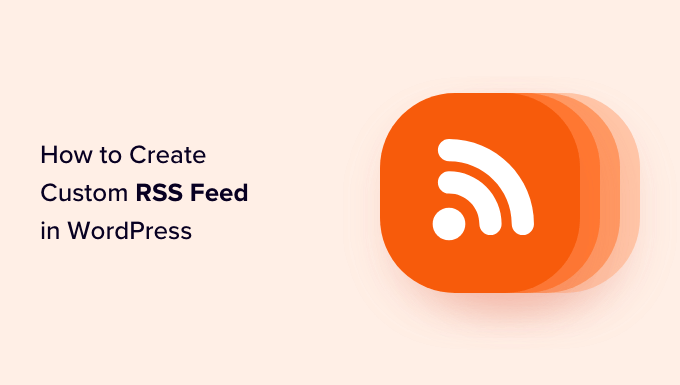
Por que criar um RSS Feed personalizado no WordPress?
O WordPress vem com um feed RSS integrado, e você pode adicionar facilmente conteúdo personalizado ou miniaturas a ele.
No entanto, se você tiver um tipo específico de conteúdo ou tipo de postagem personalizada em seu site WordPress, talvez queira criar um feed RSS personalizado para ele.
Por exemplo, se você fornecer conteúdo exclusivo para seus assinantes de autores específicos, poderá criar um feed RSS personalizado para manter seus assinantes informados sobre o conteúdo. Isso pode melhorar suas classificações nos mecanismos de pesquisa.
Além disso, os feeds personalizados oferecem mais liberdade, permitindo que você adicione o nome do autor, as datas de publicação ou qualquer outra informação relevante, fornecendo mais detalhes aos seus usuários.
Dito isso, vamos ver como criar facilmente feeds RSS personalizados no WordPress, passo a passo.
Observação: Você deve criar um backup completo do seu site WordPress antes de fazer qualquer alteração importante em um site ativo.
Como criar um feed RSS personalizado no WordPress
Você pode criar facilmente um feed RSS personalizado no WordPress adicionando um código personalizado ao arquivo functions.php do seu tema.
Esse feed exibirá o título, o link, a data de publicação, o autor e os trechos das postagens em seu site do WordPress.
No entanto, lembre-se de que o menor erro ao digitar esse código pode danificar seu site e torná-lo inacessível.
É por isso que recomendamos o uso do WPCode. Ele é o melhor plug-in de snippets de código para WordPress do mercado, o que torna fácil e seguro adicionar códigos personalizados ao seu site.
Primeiro, você precisa instalar e ativar o plug-in WPCode. Para obter instruções detalhadas, consulte nosso guia para iniciantes sobre como instalar um plug-in do WordPress.
Observação: você pode usar o plug-in gratuito do WPCode para este tutorial. No entanto, o upgrade para o plano pago desbloqueará mais recursos, como o modo de teste, a biblioteca em nuvem, a lógica condicional e muito mais.
Após a ativação, visite a página Code Snippets ” + Add Snippet na barra lateral do administrador do WordPress. Aqui, clique no botão “Use Snippet” na opção “Add Your Custom Code (New Snippet)”,

Isso o levará à página “Create Custom Snippet” (Criar snippet personalizado), onde você pode começar digitando um nome para o snippet de código.
Em seguida, escolha a opção “PHP Snippet” no menu suspenso Code Type (Tipo de código) à direita.
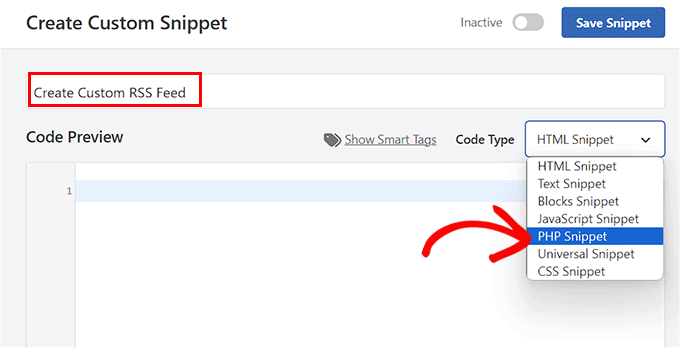
Em seguida, adicione o seguinte código personalizado na caixa “Code Preview” (Visualização de código):
1 2 3 4 5 6 7 8 9 10 11 12 13 14 15 16 17 18 19 20 21 22 23 24 25 26 27 28 29 30 31 32 33 34 35 36 37 38 39 40 41 42 43 44 45 46 | add_action('init', 'customRSS');function customRSS(){ add_feed('Feed', 'customRSSFunc');}function customRSSFunc(){ get_template_part('rss', 'feedname');/** * Template Name: Custom RSS Template - Feedname */$postCount = 5; // The number of posts to show in the feed$posts = query_posts('showposts=' . $postCount);header('Content-Type: '.feed_content_type('rss-http').'; charset='.get_option('blog_charset'), true);echo '<?xml version="1.0" encoding="'.get_option('blog_charset').'"?'.'>';?><rss version="2.0" xmlns:content="http://purl.org/rss/1.0/modules/content/" xmlns:wfw="http://wellformedweb.org/CommentAPI/" xmlns:dc="http://purl.org/dc/elements/1.1/" xmlns:atom="http://www.w3.org/2005/Atom" xmlns:sy="http://purl.org/rss/1.0/modules/syndication/" xmlns:slash="http://purl.org/rss/1.0/modules/slash/" <?php do_action('rss2_ns'); ?>><channel> <title><?php bloginfo_rss('name'); ?> - Feed</title> <atom:link href="<?php self_link(); ?>" rel="self" type="application/rss+xml" /> <link><?php bloginfo_rss('url') ?></link> <description><?php bloginfo_rss('description') ?></description> <lastBuildDate><?php echo mysql2date('D, d M Y H:i:s +0000', get_lastpostmodified('GMT'), false); ?></lastBuildDate> <language><?php echo get_option('rss_language'); ?></language> <sy:updatePeriod><?php echo apply_filters( 'rss_update_period', 'hourly' ); ?></sy:updatePeriod> <sy:updateFrequency><?php echo apply_filters( 'rss_update_frequency', '1' ); ?></sy:updateFrequency> <?php do_action('rss2_head'); ?> <?php while(have_posts()) : the_post(); ?> <item> <title><?php the_title_rss(); ?></title> <link><?php the_permalink_rss(); ?></link> <pubDate><?php echo mysql2date('D, d M Y H:i:s +0000', get_post_time('Y-m-d H:i:s', true), false); ?></pubDate> <dc:creator><?php the_author(); ?></dc:creator> <guid isPermaLink="false"><?php the_guid(); ?></guid> <description><![CDATA[<?php the_excerpt_rss() ?>]]></description> <content:encoded><![CDATA[<?php the_excerpt_rss() ?>]]></content:encoded> <?php rss_enclosure(); ?> <?php do_action('rss2_item'); ?> </item> <?php endwhile; ?></channel></rss> |
Agora você pode alterar o nome do seu feed RSS personalizado para o que quiser, substituindo o texto Feed após a linha add_feed no código.
Depois de criar esse feed, você poderá visualizá-lo acessando o URL do feed RSS. Ele terá a seguinte aparência: yourdomain.com/feed/feedname.
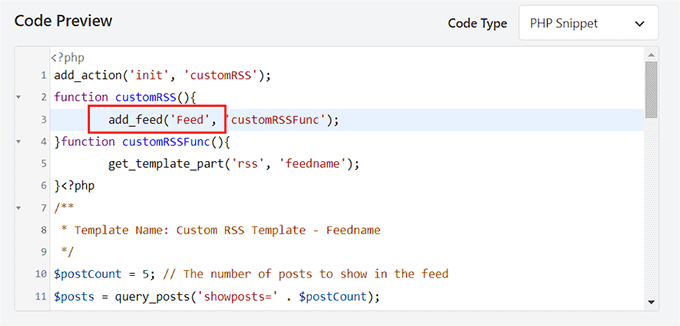
Em seguida, role para baixo até a seção de inserção e escolha o modo “Auto Insert” (Inserção automática).
O feed RSS personalizado será criado automaticamente após a ativação do código.

Por fim, role de volta para a parte superior e alterne a chave “Inactive” (Inativo) para “Active” (Ativo).
Depois disso, clique no botão “Save Snippet” para armazenar suas configurações.
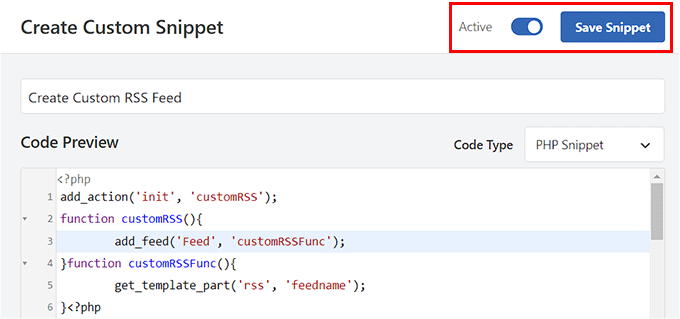
Depois de fazer isso, visite a página Configurações ” Permalinks no painel do WordPress.
Aqui, basta clicar no botão “Save Changes” (Salvar alterações) para liberar as regras de reescrita e gerar novos permalinks para seu site.
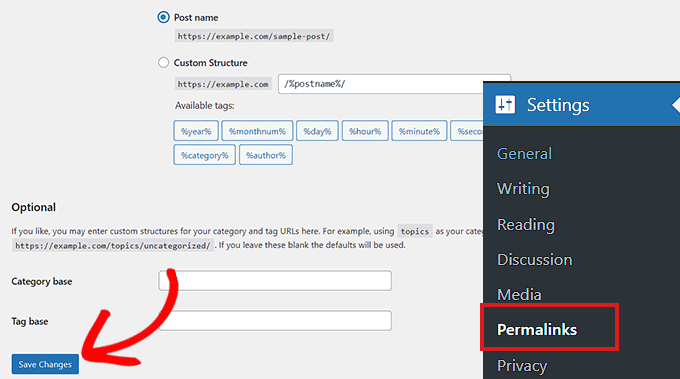
Agora você poderá visualizar seu feed RSS personalizado visitando o URL yourdomain.com/feed/feedname.
Aqui está um exemplo do feed RSS personalizado em nosso site de demonstração do WordPress:
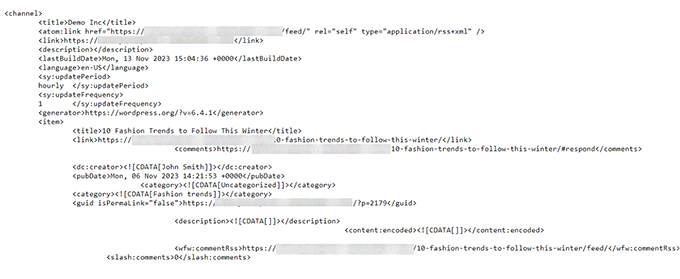
Bônus: Solução de problemas com o feed RSS personalizado
Aqui está uma lista de alguns erros que podem ocorrer ao tentar criar um feed RSS personalizado e como você pode resolvê-los.
Estou recebendo um erro 404 ao tentar visualizar meu feed!
Se você receber o erro 404 ao tentar visualizar o feed personalizado, verifique se está usando o nome correto do feed no URL.
Ele precisa ser aquele que você forneceu na função add_feed. Se você tiver o nome de feed correto, suas regras de reescrita podem não ter sido transferidas corretamente. Você pode fazer isso facilmente salvando novamente seus permalinks.
Se você salvou novamente seus permalinks e o problema ainda persiste, poderá forçar uma reescrita de descarga adicionando este código no snippet WPCode ao lado da função add_ feed:
1 2 | global $wp_rewrite;$wp_rewrite->flush_rules(); |
Meu feed não está sendo validado!
O W3C oferece um serviço de validação de feed que permite validar o feed resultante e fornece detalhes específicos sobre onde o feed não está sendo validado.
Você pode então editar facilmente o trecho de código para resolver esses problemas.
Estou recebendo um erro de validação <language />!
Isso é comum quando o idioma do RSS não foi configurado em sua instalação do WordPress.
Para fazer isso, você pode adicionar o seguinte código ao WPCode para atualizar a opção de idioma:
1 2 3 4 | function rssLanguage(){ update_option('rss_language', 'en');}add_action('admin_init', 'rssLanguage'); |
Depois de fazer isso, edite o segundo argumento da função update_option para alterar o idioma para o que você precisa. Confira a lista completa de códigos de idioma do RSS.
Depois de salvar o snippet, o erro será removido e você poderá visualizar o feed RSS personalizado.
Esperamos que este artigo tenha ajudado você a aprender como criar um feed RSS personalizado no WordPress. Talvez você também queira ver nosso guia passo a passo sobre como criar feeds RSS separados para cada categoria em seu blog do WordPress e nossas dicas de especialistas para otimizar seus feeds RSS do WordPress.
Se você gostou deste artigo, inscreva-se em nosso canal do YouTube para receber tutoriais em vídeo sobre o WordPress. Você também pode nos encontrar no Twitter e no Facebook.





Jonathan
Following this tutorial, for some reason changing the $postCount does not work.
Eg,
$postCount = 20; // The number of posts to show in the feed
Only by changing the default number inside of WordPress Reading settings does it work. Very weird. How do we overwrite the wordpress settings, or stop the wordpress settings from overriding our code?
WPBeginner Support
Your specific theme may be overriding the number of posts to show, we would first recommend checking with the support for your specific theme and they should be able to assist.
Admin
Shahid
Hi.
How i can add custom post types and custom fields in feed?
WPBeginner Support
You would want to take a look at two of our other articles below for that information.
https://www.wpbeginner.com/wp-tutorials/how-to-add-custom-post-types-to-your-main-wordpress-rss-feed/
https://www.wpbeginner.com/wp-tutorials/wordpress-custom-fields-101-tips-tricks-and-hacks/
Admin
Dexter Nelson
Is there any way to make this permanent? I keep having to repeat this step every few weeks when the theme is updated.
WPBeginner Support
For that, you would want to create a child theme following our guide below:
https://www.wpbeginner.com/wp-themes/how-to-create-a-wordpress-child-theme-video/
Admin
Dexter Nelson
Thanks. But doesn’t that mean when the theme is updated I’ll have to update the child theme? If that’s the case and I have to put in the work either way, I might as well put in the work to create and maintain a plugin and help out others instead of just myself, right?
WPBeginner Support
Child themes should not be affected by updates to the parent theme but if you have the ability to create a plugin then you can certainly go down that path to help others as well.
Thommy Kusbin
is there any plugin to do this kind of custom rss feed XML? I want to use my own tag xml.
WPBeginner Support
We do not have a recommended plugin at this time, we will be sure to keep an eye out.
Admin
MOOSA
How can I use “wp_get_shortlink()” Instead of “the_permalink_rss()”
John Snyder
I need to create an XML feed for a specific page on my WordPress website. Here is the page will I have to edit my functions.php file or is there an easier way?
Alok Shrestha
Hello,
This article is very helpful but I got some issue.
I did exactly like in your code. But it gives me an error as
This page contains the following errors:
error on line 1 at column 7: XML declaration allowed only at the start of the document
Below is a rendering of the page up to the first error.
Could you please help me out what could possibly go wrong here?
This is very important for me.
Thank you.
Nathan
I got the same error. Did you figure out the fix?
Rich
Use ob_clean(); after php tag
Guillermo
Hi, is it possible to change de order of the posts in my feeds without creating a new custom feed? I want to use the current feed files but just want to change the displayed order of theme. Using PHP queries as an example, changing order from DESC to RAND()
I will appreciate you help. Thanks.
Jeremy
Great post! I definitely fall under the rookie status. Many feed readers/aggregators don’t seems to like the /feed/ URL structure, even through the xml returned validates. Is there a way to append the url to end with rss.xml?
Dave
Did you get this to work with .xml at the end?
JDURAN
Sorry to say, however, implementing the codes for custom rss has effectively wiped out my entire blog. Having to do a restore and it is taking a long time to get my blog back up. Any advise?
Mark
You need to connect to your site via FTP or your hosting’s file browser in cPanel, and simply remove what you added. If you added the code as a custom plugin, then just rename the plugin folder. If you added the code in functions.php, edit the file and remove the code. Don’t forget to backup the file before editing. Hope this helps for the next time.
jim
Fantastic! This works as advertised!
DrLightman
Never mind, it does. I had a bug with YOAST SEO that with the /category/ prefix removal. I have warned them of it I hope they will fix it.
DrLightman
Hello, thank you for the article, but it seems this will only work for the main site feed, not for the specific catgories feeds:
mysite.com/category/mycat/feed/feedname/
Manuel
Doesn’t work anymore.
I got a 404 error, so I activated debug mode. Debug mode says “Notice: The Called Constructor Method For WP_Widget Is Deprecated Since Version 4.3.0! Use __construct()”
Manuel
Ok, I think the problem was elsewhere and this notice is from a different plugin.
git
unfortunately this is restricted in its usefulness. inserting screenshots and sample pages would be very helpful, particularly for amateurs/rookies like me.
Tiffany
Great article. Any way to add the featured image for the post to the feed?
WPBeginner Support
Please see our guide on how to add featured image to your WordPress RSS feed.
Admin
CT
Please see below screenshots – what determines the “…” or “[…]” or “Read More ->” etc etc in feeds?
I’m using the default /feed in 2 different WP sites & these 2 screenshots obviously are showing something different at the end of their excerpts. Thanks!
CT
Apologizes but that code did not come through clear lol. Lets try that again. Go here to see the exact, raw code I’m looking to remove:
WPBeginner Support
This code is added by Yoast SEO plugin to RSS feeds. You can turn it off by visting SEO » Advanced page.
Admin
Stef
Hey, I want to exclude certain post_formats from my custom rss feed. Is that possible and if so, how?
Neha
Hello,
When I try to view the feed I got 404 Page not found error. I am trying to add code:
global $wp_rewrite;
$wp_rewrite->flush_rules();
then I also got same error. Could this be why?
Jordan
How do you add multiple feeds? Array is not working. Thanks.
Jon Harvey
How would you add multiple custom feeds? Couldn’t get an array to work.
Thanks
Jon Harvey
Got it to work neatly thanks to birgire at Stack exchange:
add_action( ‘init’, ‘custom_feeds’ );
function custom_feeds()
{
foreach( array( ‘feedname1’, ‘feedname2’ ) as $name )
{
add_feed( $name,
function() use ( $name )
{
get_template_part( ‘rss’, $name );
}
);
}
}
Neal Pope
The “follow” button shows up at the bottom right corner when viewing posts on a personal computer, but does not appear when viewing on a mobile devise (smartphone) (unless I’m just missing it.
Limbani
Thanks for sharing it’s work perfectly…
Jeff
Sorry, but everything about this is misleading. this is not “beginner” work. and it is not worded for beginners. This is totally irresponsible and can cause major issues to people’s websites.
WPBeginner Support
We have updated the article to add a note about this.
Admin
Christine
I got this working (kind of). The feed page exists, but will not validate and says there is an error on line 1.
I copied the code exactly from this page and haven’t changed anything. What could be going wrong here?
Flávia
W3 will not validate mine as well and says there is an error on line 17.
And I am getting the 404 page!
What should I do?
Eugene Asiamah
Hello,
Please i need help in configuring my rss to show all my post content on not just an excerpt of it.
Thank you.
Georgi
Hello,
I need to show only date without time for pubDate. When I use
It’s doesn’t work for firefox,IE.
Can you help me?
Thank you in advance!
Jan-Philipp
Hi.
I would like to change the update pattern of the feed with
sy:updatePeriod
echo apply_filters( ‘rss_update_period’, ‘weekly’ );
/sy:updatePeriod
sy:updateFrequency
echo apply_filters( ‘rss_update_frequency’, ‘1’ );
/sy:updateFrequency>
sy:updateBase
2015-03-29T01:00:00+09:00
/sy:updateBase
But whatever I tried, it automatically adds a new post when I publish it and does not wait till Sunday ( as defined in the code above) to add it to the RSS.
Do you have any suggestions? Do I maybe need to find a solution within the WP Query?
Your help would be much appriciated.
Jan-Philipp
Hi.
I would like to change the update pattern of the feed with
2015-03-29T01:00:00+09:00
But whatever I tried, it automatically adds a new post when I publish it and does not wait till Sunday ( as defined in the code above) to add it to the RSS.
Do you have any suggestions? Do I maybe need to find a solution within the WP Query?
Your help would be much appriciated.
Issabellla
Hi.I try to do as your mention but I’ve seen my site cannot access to the feed page.This is My site I try to use /feed and a lot of word which is mention in wordpress.com or wordpress.org even in the google.Please help me.
WPBeginner Support
Your site’s feed looks fine to us.
Admin
xuamox
What determines that the feed will be displayed at feed/feedname? I have tried to follow the tutorial, but not luck at all. The feed is not publishing at feed/feedname.php
Wouter Bertels
Following these exact steps I got this error:
Fatal error: Cannot redeclare get_bloginfo_rss() (previously
declared in
/home/public_html/wp-includes/feed.php:25)
in /home/public_html/wp-content/themes/xxx/rss-name.php on line 39
George
Hi,
My feed is OK when this code is added:
global $wp_rewrite;
$wp_rewrite->flush_rules();
and returns a 404 when it is removed.
I only remove it as per your instructions, which is to remove it after reloading wordpress.
At this moment I am testing it on my local server. Could this be why?
ybmgryzzz
Hi there. Thanks for this post! Really appreciated. Worked well at first go!
I would also like some assistance as Brian below. For the full text in the RSS instead of the post excerpt.
Thanks in advance.
Brian
I am trying to add a second RSS feed that is full text (my first RSS feed is summary). If I wanted this custom RSS feed to be full text instead of summary excerpt, what would I change?
Thanks so much!
Steve Marks
Thanks for this. Just what I was looking for!
I had an issue when I used add_feed(). I could view the RSS feed in the browser absolutely fine, but it would return a 404 when I entered the URL into a third party application (ie. MailChimp, W3C feed validator etc). I had tried flushing the permalinks etc.
The only way I could get round the issue was to create a new blank page and select the template as the one you’ve outlined in this article.
Not sure why it didn’t work, but hopefully this offers a viable solution for others in this situation.
Thanks again!
Josh McClanahan
Your article is right on the path of what I was looking for. One question I have (as a noob to RSS), how can I add a link to an RSS feed?
The site that I need this for is a church and would like to have a custom feed that would make it easier for our members to be alerted to newly posted sermon posts (that have mp3 download links).
Currently, the feed shows the text for the links that I have created on the posts for the sermons. But it only acts as text. Any help would be appreciated.
Josh McClanahan
Just noticed that I didn’t ask my question correctly.
What I was trying to ask was, how can I display a link in the RSS Feed? The links that are in the content of my posts are broken in the feed.
Thanks for your help and this article.
Josh McClanahan
Still curious, if anyone knows why my links would be broken and only show as plain text in a feed?
To see what I mean checkout: http://amfmchurch.com/feed
You will see “Download” in plain text. I would like to make it so that people can click the anchor link and download the mp3. This works find on the actual site.
Thanks for any help.
Neil
Hi, I have the default rss feed.. but I would like to be able to either reduce the size of the images from what is displayed in the post…. (to a maximujm width of 265px) OR to just use the post thumbnail in the rss.
Is either of the above possible?
The reason I am looking to do this is that my RSS feeds an APP and the APP will only display images up to 265px in width (before horizontal scrolling) and 265px is very limiting for online/pc blog posts…
Cathy Finn-Derecki
Thank you for this! I am making a custom RSS location part of a plugin I’m developing. As a result, I have included the text for the custom RSS in the function, not in a theme template. It’s working. However, it does not seem to work when I want to restrict the feed to a category. It gives all posts regardless. Any thoughts?
WPBeginner Support
try changing
$posts= query_posts('showposts='.$postCount);1-click Use in WordPress
To:
$posts= query_posts('showposts='.$postCount.'&category_name=staff');1-click Use in WordPress
Replace category_name with your category name.
Admin
Francisco Espinoza
Hi Guys. How can I use this to exclude three categories from my new custom feed? What do you suggest?
Alexis
Hello,
Thank you, these explanations are really useful. I just used it to customize my feed so I could put an image in mailchimp’s “RSS to email” feature.
Thank you very much !
the Off
Hello,
Till yesterday afternoon, my WordPress (version 3.6.1) blog http://theoff.info/wordpress/ had no problem. And I successfully added new plugins.
In the night, problems started: (1) I could not login. (2) the RSS feed http://theoff.info/wordpress/?feed=rss2 got corrupted. The feed failed validation.
I searched the Web and WordPress Support Forum for solutions. I tried the following:
(i) successfully reset the password
(ii) deleted new plugins from ftp
(iii) renamed Theme folder by adding “-old” and plugin folder by adding “-hold” from ftp
Then I could login and up grade to 3.7.1 version and make changes to the blog.
However, login is still an issue. Every time I am following method mentioned in step (iii) to login.
RSS still does not validate.
Could you help in resolving both login and RSS feed problems?
Note: My webhost does not offer technical help. I am not an IT professional i.e. I have very little technical knowledge.
Thanks
WPBeginner Support
It is difficult to figure out. Here is one thing you can try.
1. Using FTP download your plugins to your computer for backup and then delete your plugins directory.
2. Create a new plugins directory.
3. Install and all your plugins one by one by downloading fresh copy of the plugin from the source. After you activate each plugin log out and and log back in to see if the problem occurs again. You will probably find a plugin that may be causing the problem or you wont. This could mean that a plugin file on your site may have been compromised.
If this process does not help you, repeat this process process with your themes as well. If you have made a lot of changes to your existing themes then you might want to back it up on your computer by downloading theme folder through FTP. Then delete themes folder from your webserver and create a new themes directory in wp-content folder on your server. From WordPress admin area download and install a fresh copy of default twenty thirteen theme.
Let us know what happens when you do all that. Make Sure to Backup your Site first.
Admin
Bertrand
Hello,
When I try to open the new feed, I get an error message:
Fatal error: Call to undefined function query_posts() in /xxxx/wp-content/themes/xxx/rss-feedname.php on line 6
I tried on localhost and web hosting, it is the same…
How can I fix it?
Thanks
Bertrand
My fault: http://wordpress.org/support/topic/error-message-call-to-undefined-function-query_posts?replies=5
ADv
Does the php template need close tag ?> in the end?
ADv
No, it doesn’t. Silly me = )